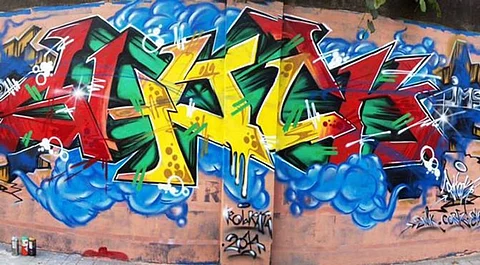
- Home
- न्यूजग्राम
- India
- World
- Politics
- Entertainment
- Culture
- Lifestyle
- Economy
- Sports
- Sp. Coverage
- Misc.
- NewsGram Exclusive
- Jobs / Internships

Kolkata: Armed with spray cans and creativity, a group of youngsters are steadily turning Kolkata's walls – for long splattered with political slogans and quack cures – into graffiti artscapes, painting the city red, blue and a variety of hues.
A motley crew of young men and women, with pseudonyms as fanciful as their creations, is etching its artistic and social imagination and giving a new definition to the walls, predominantly considered a domain of the political parties in West Bengal.
The otherwise mundane walls in the eastern metropolis have always been a crucial component of the animated political jargon in the state, with parties reaching out to the masses with slogans that are at times witty, satirical, assertive and even thought provoking, but also at times aggressive, contemptuous and full of hatred.
But, basking in anonymous glory, the SREKs, SHAFs and the SNIKs sneak out in the middle of the night to "reclaim" their canvas – city walls covered with slogans – braving attacks from political parties and even police action.
"Politics is a nuisance – be it political graffiti or the politicians themselves. Our 'street art' is an attempt to give colour to this otherwise mundane grey world," SNIK, 'revered' as the 'godfather' of Kolkata graffiti, told IANS.
Credited with pioneering the 'guerrilla art' in the city, SNIK's love affair with graffiti began while studying in Sydney.
"I mostly started off doing black books and canvases, then moved on to doing basic tags on walls. Returning to Kolkata, I met a few guys at a hip-hop jam and communicating through Facebook and jamming, we began our bid to reclaim the city walls splattered with political hatred and laughable quack cures," said SNIK, who runs a restaurant in the city.
While its origin can be traced to the cave art of the Paleolithic Age, modern graffiti is perceived as a defiance of
authority and vandalism. Most street artists traditionally prefer to stay anonymous, adopting pseudonyms, fearing a backlash and police action.
World famous for his satirical street art and subversive epigrams, the real identity of British graffiti artist Banksy' still remains unknown.
But for the graffiti artists, it's a colourful medium of expression, an art and an addiction for which they are ready to risk police action – or even getting on the wrong side of activists of political parties.
"Graffiti is my addiction; it takes me to a world of my own where I express myself through my colours, my scribbles…The feeling is beyond words… where you scream out your thoughts to the world and yet remain anonymous," said SHAF, who, with his 'partner in crime' SREK, is one of leading 'graffiti cru' in the city.
"While we mostly seek permission when doing graffiti on private properties, political party activists perceive our art as an invasion and there have been instances when we had to run for our lives on being chased by them," SREK said.
SNIK's 'cru' partner SHOCK was caught by the police while spraying on a Metro train and tracks, but was let off with a warning.
The graffiti gangs are not a bunch of aimless artists blindly aping the hip-hop culture. For them, graffiti is as much an art as a means to defy disapproving social norms.
The vibrant colours symbolise their exuberance and the graffiti – the declaration of their existence to the world.
"How many people can walk through a city and prove they were there? It's a sign I was here. My hand made this mark…My existence counts…," said SNIK, whose graffiti is not 'mere scribbles' but is also an "expression of the youth's spirit of rebellion'.
The advent of digital printing and the use of flexes and hoardings may have reduced the significance of political graffiti, but with the 2016 assembly polls on the horizon, the battle for the walls is all set to intensify.
"As the saying goes, where there is a will there is a way. Our spray cans too will find the canvasses. Far from days when people considered us vandals and even had contempt for our art, graffiti steadily is gaining in popularity.
"People now willingly allow us to etch our dreams on their walls. Polls or not, our crusade will continue," SHAF asserted.
Famed painter Samir Aich has lent his support to the graffiti gang in their crusade.
"But for these young men and women, calligraphy would be dead. All their creations are a mural to be appreciated. The colours, the intricate designs, they are all a piece of art," Aich said.
"It's time our walls get rid of political graffiti – all their colours, and each and every letter reeks of hatred and deceit," Aich added.
(Anurag Dey, IANS)
